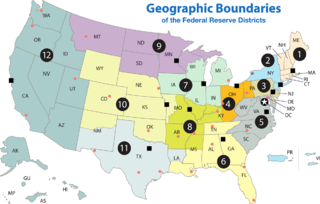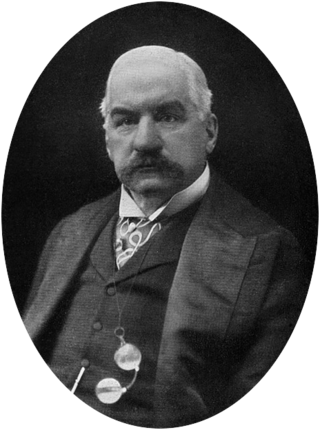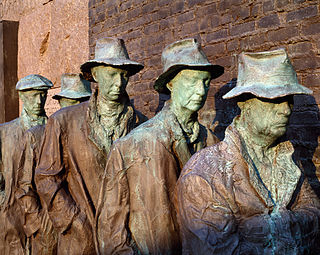This article needs additional citations for verification .(August 2010) |
The main belief behind the concept of a money trust is that the majority of the world's financial wealth and political power could be controlled by a powerful few.
This article needs additional citations for verification .(August 2010) |
The main belief behind the concept of a money trust is that the majority of the world's financial wealth and political power could be controlled by a powerful few.
This idea was validated in the United States by the Pujo Committee in 1913 which unanimously determined that a small cabal of financiers had gained consolidated control of numerous industries through the abuse of the public trust. The chair of the House Committee on Banking and Currency, Representative Arsène Pujo, (D–La. 7th) convened a special committee to investigate a "money trust", the de facto monopoly of Morgan and New York's other most powerful bankers. The committee issued a scathing report on the banking trade, and found that the officers of J.P. Morgan & Co. also sat on the boards of directors of 112 corporations with a market capitalization of $22.5 billion (the total capitalization of the New York Stock Exchange was then estimated at $26.5 billion). [1]
Attorney Samuel Untermyer who headed the 1913 Pujo Money Trust Investigation Committee to investigate money trusts defined a money trust to George Baker during the Pujo hearings; "We define a money trust as an established identity and community of interest between a few leaders of finance, which has been created and is held together through stock-holding, interlocking directorates, and other forms of domination over banks, trust companies, railroads, public service and industrial corporations, and which has resulted in vast and growing concentration and control of money and credits in the hands of a few men". [2]
The Pujo Committee Report concluded in 1913 that a community of influential financial leaders had gained control of major manufacturing, transportation, mining, telecommunications and financial markets of the United States. The report revealed that no less than eighteen different major financial corporations were under control of a cartel led by J .P. Morgan, George F Baker and James Stillman. These three men, through the resources of seven banks and trust companies (Bankers Trust Co., Guaranty Trust Co., Astor Trust Co., National Bank of Commerce, Liberty National Bank, Chase National Bank, and Farmer’s Loan and Trust Co.) controlled an estimated $2.1 billion. The report revealed that a handful of men held manipulative control of the New York Stock Exchange and attempted to evade interstate trade laws.
The Pujo Report singled out individual bankers including Paul Warburg, Jacob H. Schiff, Felix M. Warburg, Frank E. Peabody, William Rockefeller and Benjamin Strong, Jr. The report identified over $22 billion in resources and capitalization controlled through 341 directorships held in 112 corporations by members of the empire headed by J.P. Morgan. [3]
Although Pujo left Congress in 1913, the findings of the committee inspired public support for ratification of the Sixteenth Amendment in 1913, passage of the Federal Reserve Act that same year, and passage of the Clayton Antitrust Act in 1914. They were also widely publicized in the Louis Brandeis book, Others People's Money--and How the Bankers Use It. [4]

The Federal Reserve System is the central banking system of the United States. It was created on December 23, 1913, with the enactment of the Federal Reserve Act, after a series of financial panics led to the desire for central control of the monetary system in order to alleviate financial crises. Over the years, events such as the Great Depression in the 1930s and the Great Recession during the 2000s have led to the expansion of the roles and responsibilities of the Federal Reserve System.

The Federal Reserve Act was passed by the 63rd United States Congress and signed into law by President Woodrow Wilson on December 23, 1913. The law created the Federal Reserve System, the central banking system of the United States.
Investment banking pertains to certain activities of a financial services company or a corporate division that consist in advisory-based financial transactions on behalf of individuals, corporations, and governments. Traditionally associated with corporate finance, such a bank might assist in raising financial capital by underwriting or acting as the client's agent in the issuance of debt or equity securities. An investment bank may also assist companies involved in mergers and acquisitions (M&A) and provide ancillary services such as market making, trading of derivatives and equity securities, FICC services or research. Most investment banks maintain prime brokerage and asset management departments in conjunction with their investment research businesses. As an industry, it is broken up into the Bulge Bracket, Middle Market, and boutique market.

A Federal Reserve Bank is a regional bank of the Federal Reserve System, the central banking system of the United States. There are twelve in total, one for each of the twelve Federal Reserve Districts that were created by the Federal Reserve Act of 1913. The banks are jointly responsible for implementing the monetary policy set forth by the Federal Open Market Committee, and are divided as follows:

John Pierpont Morgan Sr. was an American financier and investment banker who dominated corporate finance on Wall Street throughout the Gilded Age. As the head of the banking firm that ultimately became known as J.P. Morgan and Co., he was the driving force behind the wave of industrial consolidation in the United States spanning the late 19th and early 20th centuries.
Chemical Bank was a bank with headquarters in New York City from 1824 until 1996. At the end of 1995, Chemical was the third-largest bank in the U.S., with about $182.9 billion in assets and more than 39,000 employees around the world.
Swiss Bank Corporation was a Swiss investment bank and financial services company located in Switzerland. Prior to its merger, the bank was the third largest in Switzerland with over CHF 300 billion of assets and CHF 11.7 billion of equity.

The Panic of 1907, also known as the 1907 Bankers' Panic or Knickerbocker Crisis, was a financial crisis that took place in the United States over a three-week period starting in mid-October, when the New York Stock Exchange fell almost 50% from its peak the previous year. The panic occurred during a time of economic recession, and there were numerous runs on banks and on trust companies. The 1907 panic eventually spread throughout the nation when many state and local banks and businesses entered bankruptcy. The primary causes of the run included a retraction of market liquidity by a number of New York City banks and a loss of confidence among depositors, exacerbated by unregulated side bets at bucket shops.
This history of central banking in the United States encompasses various bank regulations, from early wildcat banking practices through the present Federal Reserve System.

Paul Moritz Warburg was a German-born American investment banker who served as the second vice chairman of the Federal Reserve from 1916 to 1918. Prior to his term as vice chairman, Warburg served as one of the original members of the Federal Reserve Board of Governors, taking office in 1914. He was an early advocate for the establishment of the US central bank system.
J.P. Morgan & Co. is an American financial institution specialized in investment banking, asset management and private banking founded by financier J. P. Morgan in 1871. Through a series of mergers and acquisitions, the company is now a subsidiary of JPMorgan Chase, one of the largest banking institutions in the world. The company has been historically referred to as the "House of Morgan" or simply Morgan. For 146 years, until 2000, J.P. Morgan specialized in commercial banking, before a merger with Chase Manhattan Bank led to the business line spinning off under the Chase brand.

The Pecora Investigation was an inquiry begun on March 4, 1932, by the United States Senate Committee on Banking and Currency to investigate the causes of the Wall Street Crash of 1929. The name refers to the fourth and final chief counsel for the investigation, Ferdinand Pecora. His exposure of abusive practices in the financial industry galvanized broad public support for stricter regulations. As a result, the U.S. Congress passed the Glass–Steagall Banking Act of 1933, the Securities Act of 1933, and the Securities Exchange Act of 1934.
Other People's Money And How the Bankers Use It (1914) is a collection of essays written by Louis Brandeis first published as a book in 1914, and reissued in 1933. This book is critical of banks and insurance companies.

Arsène Paulin Pujo was a member of the United States House of Representatives best known for chairing the "Pujo Committee", which sought to expose an anticompetitive conspiracy among some of the nation's most powerful financial interests (trusts).
The Manhattan Company was a New York bank and holding company established on September 1, 1799. The company merged with Chase National Bank in 1955 to form the Chase Manhattan Bank. It is the oldest of the predecessor institutions that eventually formed the current JPMorgan Chase & Co.

The Pujo Committee was a United States congressional subcommittee in 1912–1913 that was formed to investigate the so-called "money trust", a community of Wall Street bankers and financiers that exerted powerful control over the nation's finances. After a resolution introduced by congressman Charles Lindbergh Sr. for a probe on Wall Street power, congressman Arsène Pujo of Louisiana was authorized to form a subcommittee of the House Committee on Banking and Currency. In 1913–1914, the findings inspired public support for ratification of the Sixteenth Amendment that authorized a federal income tax, passage of the Federal Reserve Act, and passage of the Clayton Antitrust Act.
This article is about the history of the United States Federal Reserve System from its creation to the present.

Benjamin Strong Jr. was an American banker. He served as Governor of the Federal Reserve Bank of New York for 14 years until his death. He exerted great influence over the policy and actions of the entire Federal Reserve System and indeed over the financial policies of all of the United States and Europe.
Philadelphia financier Jay Cooke established the first modern American investment bank during the Civil War era. However, private banks had been providing investment banking functions since the beginning of the 19th century and many of these evolved into investment banks in the post-bellum era. However, the evolution of firms into investment banks did not follow a single trajectory. For example, some currency brokers such as Prime, Ward & King and John E. Thayer and Brother moved from foreign exchange operations to become private banks, taking on some investment bank functions. Other investment banks evolved from mercantile firms such as Thomas Biddle and Co. and Alexander Brothers.
This article details the history of banking in the United States. Banking in the United States is regulated by both the federal and state governments.